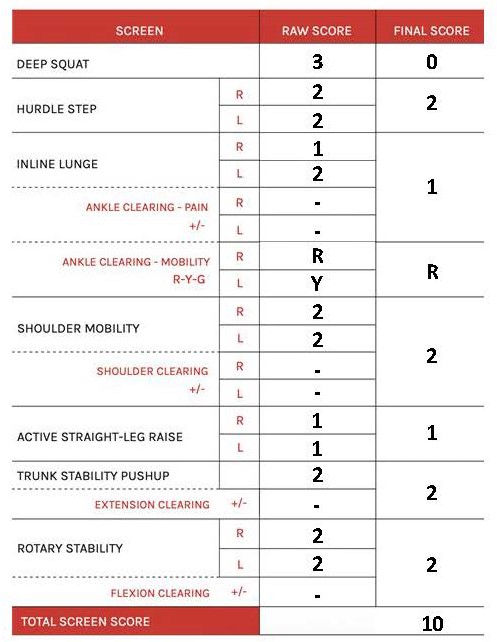FMS Score Sheets: Tips on Using and How to Document
Written by Lee Burton FMS
There are options on how to document your screening results, but we hope this article will provide some insight on why we recommend documenting the scores on the FMS score sheet. The important aspect when documenting the scores is to be consistent and follow the rules of the scoring criteria. Over the years, I have seen many different versions, some contain verbal instructions, some contain the scoring criteria and some have even been even more detailed. All are acceptable and feel free to alter the scoring document to fit your needs, just remember when it comes to documenting your scores follow the rules.
 The score sheet we provide was designed to be simple and not create a lot of confusion when documenting your scores. Remember the FMS is designed to be a quick screen where we do not want to create opportunities to overanalyze the specific tests. The scoring criteria should guide your scoring - don't fall into the trap of adding additional criteria! Mark the score and move on. Feel free to add any notes for your observations of their movement - anything that may help you make good decisions for the individual. In my experience these notes will give you much more information as you analyze results.
The score sheet we provide was designed to be simple and not create a lot of confusion when documenting your scores. Remember the FMS is designed to be a quick screen where we do not want to create opportunities to overanalyze the specific tests. The scoring criteria should guide your scoring - don't fall into the trap of adding additional criteria! Mark the score and move on. Feel free to add any notes for your observations of their movement - anything that may help you make good decisions for the individual. In my experience these notes will give you much more information as you analyze results.
The FMS scoring sheet provides you with a Raw Score, Final Score and a Total Score. All of these scores are very important when determining your intervention strategies. Let's review the different scoring categories:
- Raw Score - The raw score represents the right and left side results of the five tests that allow for bilateral comparision. It provides us the best profile of how the individual is moving and allows for the most specific intervention choices.
- Final Score - The final score is simly the lower of the two Raw Scores. For example, if an individual's Hurdle Step is a "1" on the right and a "2" on the left, the final score would be recorded as a "1". This allows for a quick overview of the patterns to determine which pattern should be a priority.
- Total Score - The total score is the sum of the Final Scores. This provides the least amount of individual pattern information, but does allow for categorization of participants.
These scores will be utilized differently depending on your setting, whether you are a fitness professional working one-on-one or you are a strength and conditioning coach at a high school working with a couple of hundred athletes. If you are working one-on-one, you may be using the Raw Score to determine the intervention; in a situation where you have large groups, the Final Score may be more important initially. The Total Score may be important when comparing to other groups, individuals or explaining it to individuals.
When referring to some of the current and future research the Final and Total Scores are often used to determine cut-off for injury risk, performance and general trends in different populations. However, this doesn’t discount the importance of the Raw Score, this score gives you the best profile of how the individual is moving. As you become proficient in the FMS system, you will find yourself using all the scores to your benefit.
The scoring format is certainly easy to follow, however the confusion comes when pain is provoked and when incorporating the three clearing test into the scoring system.
 It is very clear in the scoring criteria that when pain is noted a "0" is given and a more detailed evaluation from a medical professional is recommended. Without getting into the debate on what is and isn’t pain, I want to discuss simply how you should document the "0" score.
It is very clear in the scoring criteria that when pain is noted a "0" is given and a more detailed evaluation from a medical professional is recommended. Without getting into the debate on what is and isn’t pain, I want to discuss simply how you should document the "0" score.
You should consider two options depending on your professional background and setting. The first way to document the "0" score would be to give the individual a Raw and Final score of 0, stop the test and refer. The second option will give you and the medical professional more specific information when performing the evaluation. If a person exhibits pain during a test, you could continue on with the rest of the FMS and only document the "0" score in the Final Score section. For example, a person could get a "3" on the Deep Squat test but have pain in the knee; the Raw Score would be "3" and the Final Score a "0". If you use this option, you will now have more information to utilize when referring or performing a more detailed evaluation.
There are four screens that use Clearing Tests, which are not scored since they are only used to determine if pain is provoked. These tests are documented as a “Positive” for pain or a “Negative” for no pain, however they do influence the Final Score but not the Raw Score. The results of the clearing tests will make the Final Score a 0 if pain is provoked.
Many times we get the question as to why we would even need to document a Raw Score if the Clearing Tests override it. The answer is quite simple, if pain is provoked we want to gather as much information on that person as necessary prior to the more detailed evaluation being performed. For example during the Shoulder Mobility Screen you have two individuals, the first gets a "3" on the Right and "3" on the Left, the second gets a "2" on the Right and "1" on the Left and they both get a Positive on the Clearing Test. The final score for both of these individuals is "0" but they have completely different movement patterns, which may be the cause of pain. By having the Raw Score, we can now direct the focus of the evaluation and intervention strategies.
Hopefully, these few tips will allow you to understand the overall scoring system as well as use the results more effectively. The FMS was designed to be a simple grading system, however the more proficient you become at using the FMS and its results the more effective interventions you can provide.





